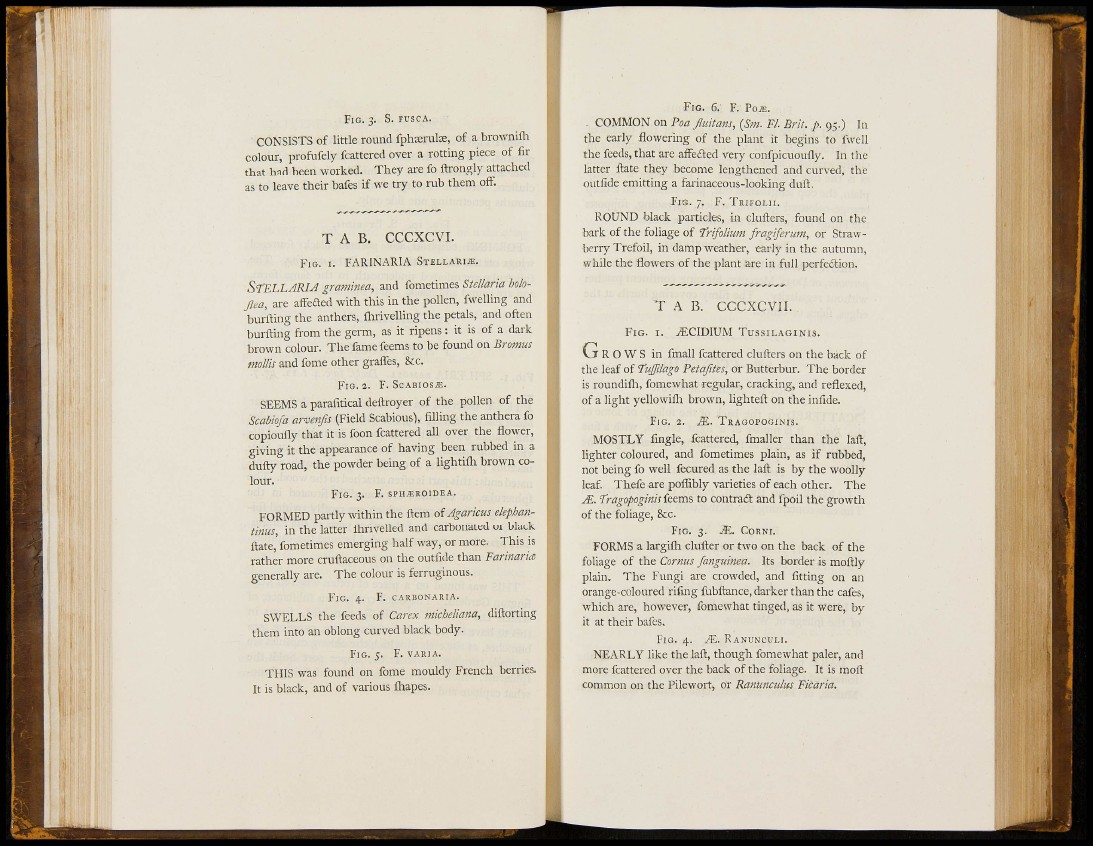
FIG. 3. S. ruscA.
CONSISTS of little round fpliEerute, of a brownilli
colour, profufely fcattered over a rotting piece of fir
that had been worked. They are fo ftrongly attached
as to leave their bafes if we try to rub them off.
T A B . CCCXCVI.
F I G . I. FARINARIA STELLARIJE.
STELLARIJ gramínea, and fometimes Stellaria holo-
Jlea, are affefled with this in the pollen, fwelling and
burfting the anthers, flirivelling the petals, and often
burfting from the germ, as it ripens: it is of a dark
brown colour. The fame feems to be found on Bromus
mollis and fome other graffes, &c.
F I G . 2. F. SCABIOS.®.
SEEMS a parafitical deftroyer of the pollen of the
Scabiofa arvenfis (Field Scabious), filling the anthera fo
copiouily that it is foon fcattered all over the flower,
giving it the appearance of having been rubbed in a
dufty road, the powder being of a lightifli brown colour.
F I G . 3. F. SPH«ROIDEA.
FORMED partly within the flem oiAgaricus elephantinus,
in the latter flirivelled and carbonated or black
ñate,' fometimes emerging half way, or more. This is
rather more cruftaceous on the outfide than FarinarU
generally are. The colour is ferruginous.
F I G . 4. F. CARBONARIA.
SWELLS the feeds of Carex micheliana, diflorting
them into an oblong curved black body.
F I G . 5. F. VARIA.
THIS was found on fome mouldy French berries.
It is black, and of various ihapes.
F I G . 6. F. PO^.
COMMON on Poa fluitans, {Sm. Fl. Brit. p. 95.) In
the early flowering of the plant it begins to fwell
the feeds, that are afFeaed very confpicuoufly. In the
latter ftate they become lengthened and curved, the
outfide emitting a farinaceous-looking daft.
F i s . 7. F. TRI-FOLII.
ROUND black particles, in clufters, found on the
bark of the foliage of Trifolium fragiferum, or Strawberry
Trefoil, in damp weather, early in the autumn,
while the flowers of the plant are in full perfe6lion.
T A B . CCCXCVII.
F I G . I. ^CIDIUM TUSSILAGINIS.
G R O W S in fmall fcattered clufters on the back of
the leaf of Tuffilago Petajites, or Butterbur. The border
is roundifli, fomewhat regular, cracking, and reflexed,
of a light yellowifti brown, lighteft on the infide.
FJG. 2. JE. TRAGOPOGINIS.
MOSTLY fingle, fcattered, fmaller than the laft,
lighter coloured, and fometimes plain, as if rubbed,
not being fo well fecured as the laft is by the woolly
leaf Thefe are poifibly varieties of each other. The
j^. fragopoginisteem^ to contraft and fpoil the growth
of the foliage, &c.
FIG. 3. JS.. CoRNi.
FORMS a largiili clufter or two on the back of the
foliage of the Cornus fanguinea. Its border is moftly
plain. The Fungi are crowded, and fitting on an
orange-coloured rifing fubftance, darker than the cafes,
which are, however, fomewhat tinged, as it were, by
it at their bafes.
F I G . 4. JE. RANUNCULI.
NEARLY like the laft, though fomewhat paler, and
more fcattered over the back of the foliage. It is inoft
common on the Pilewort, or Ranunculus Ficaria.